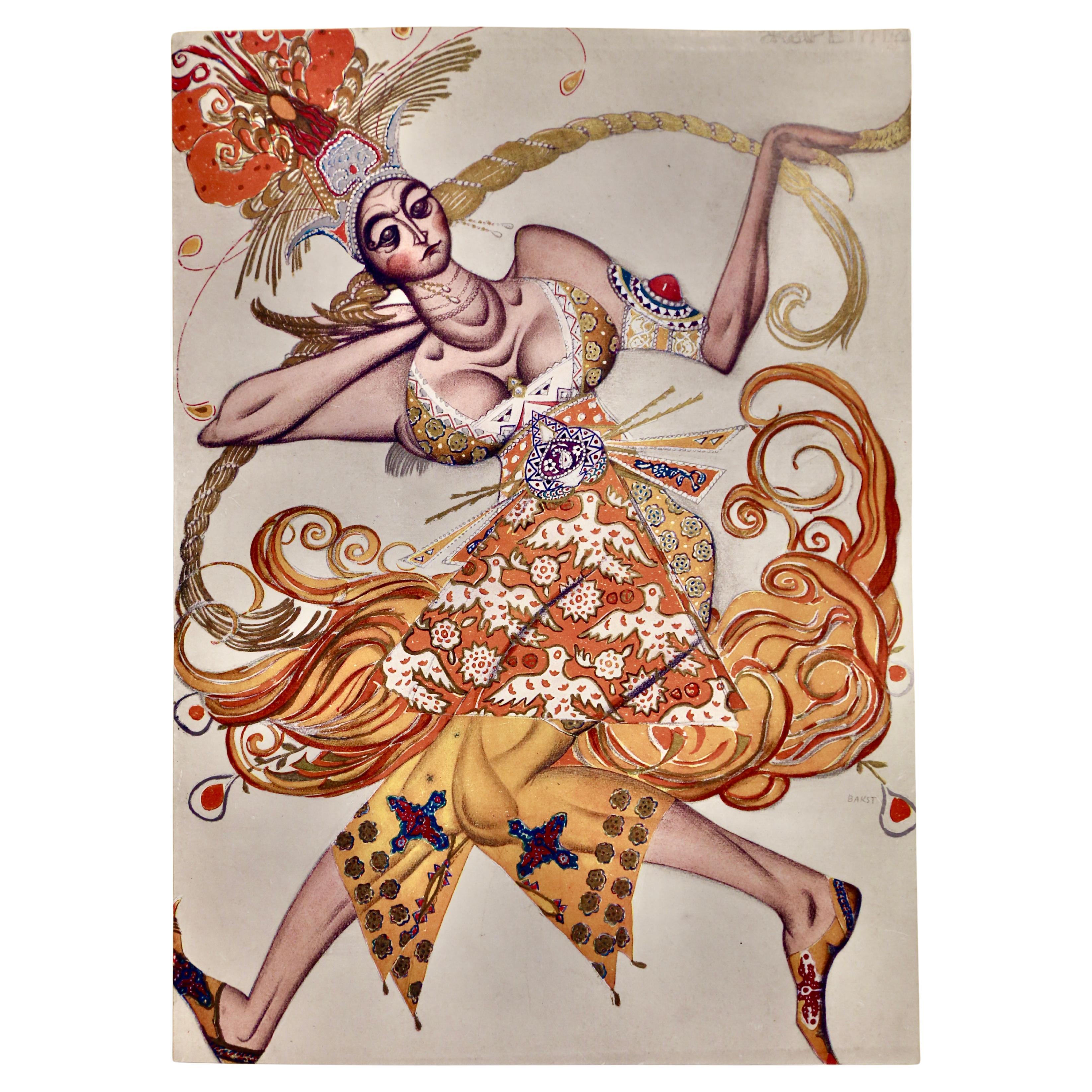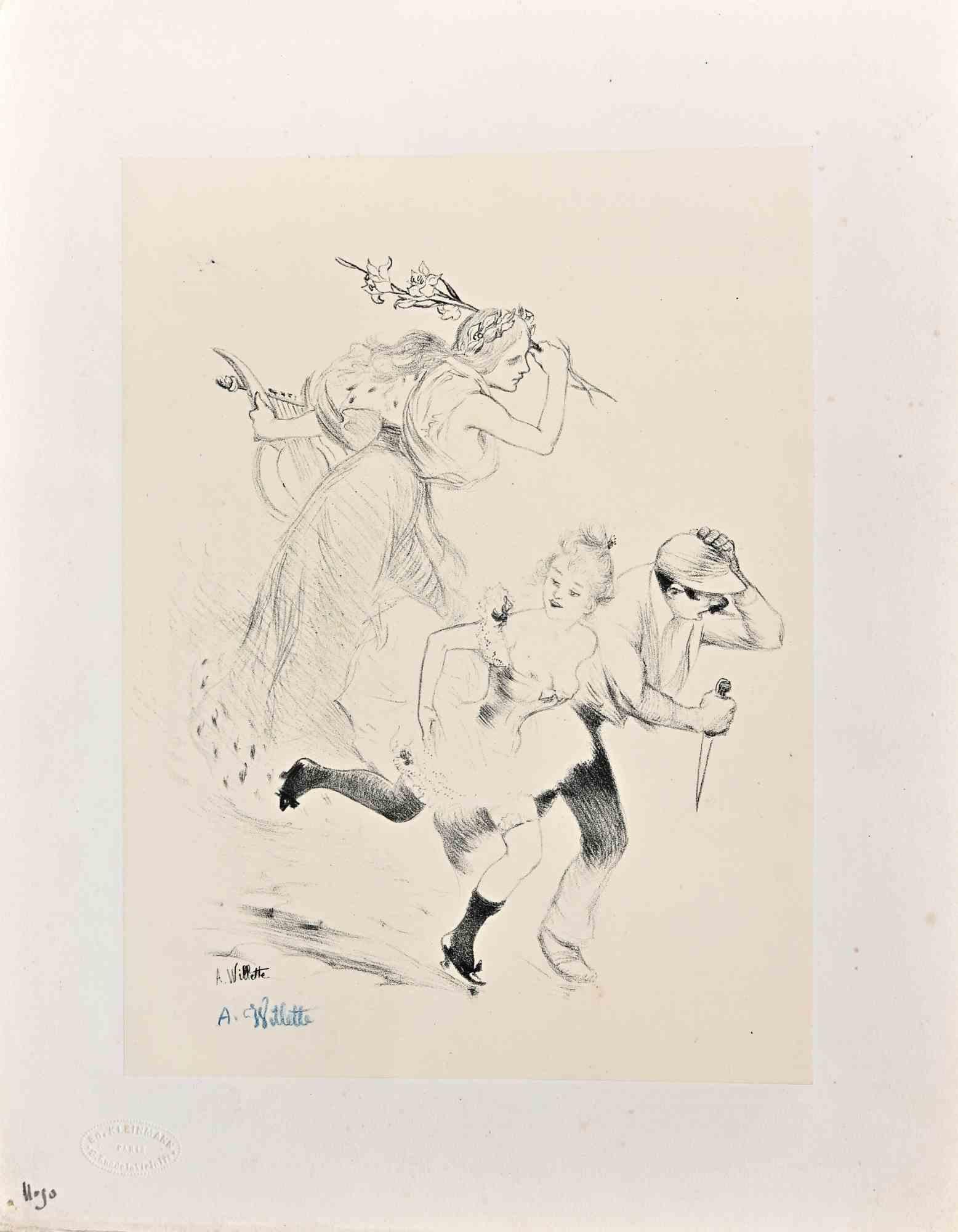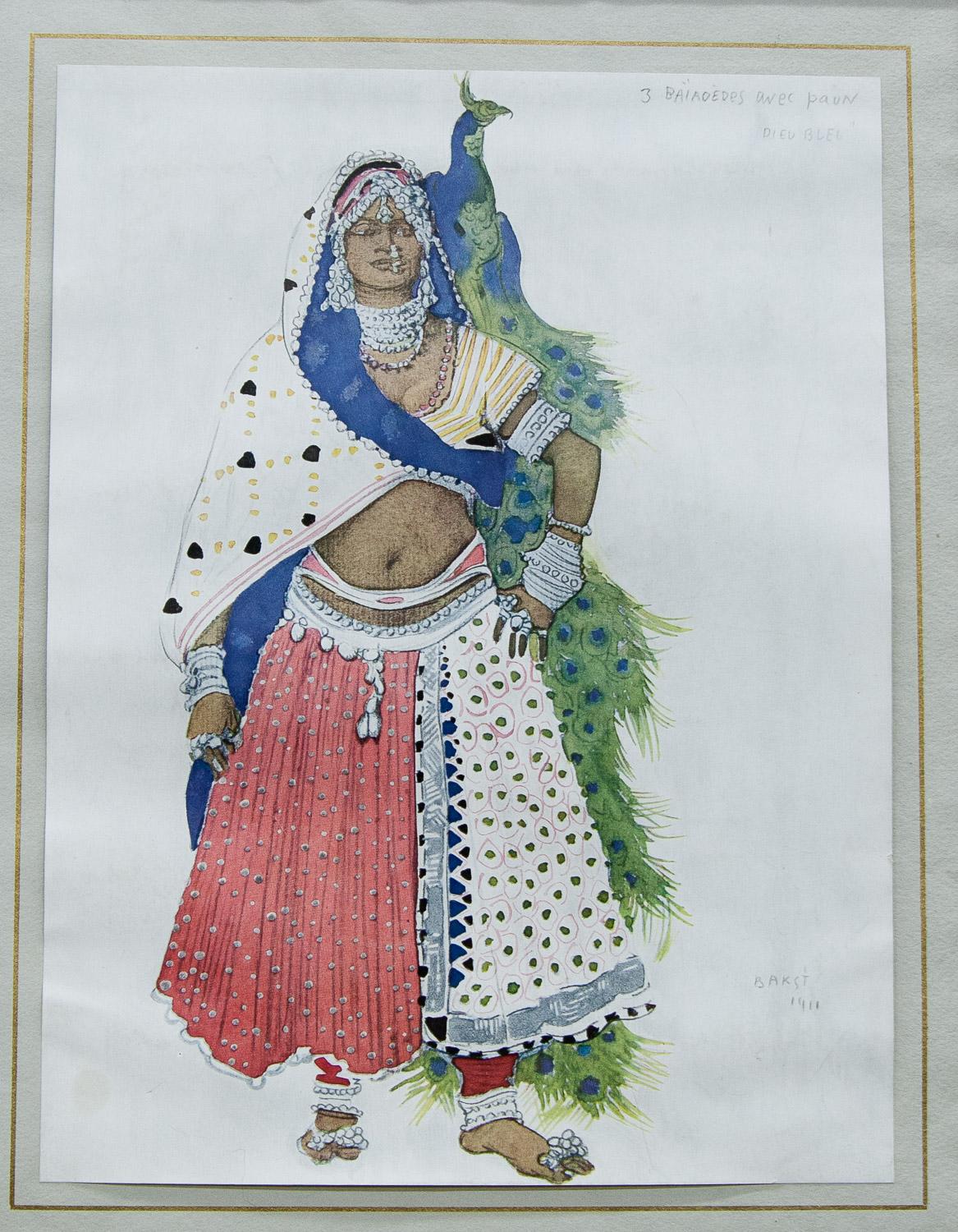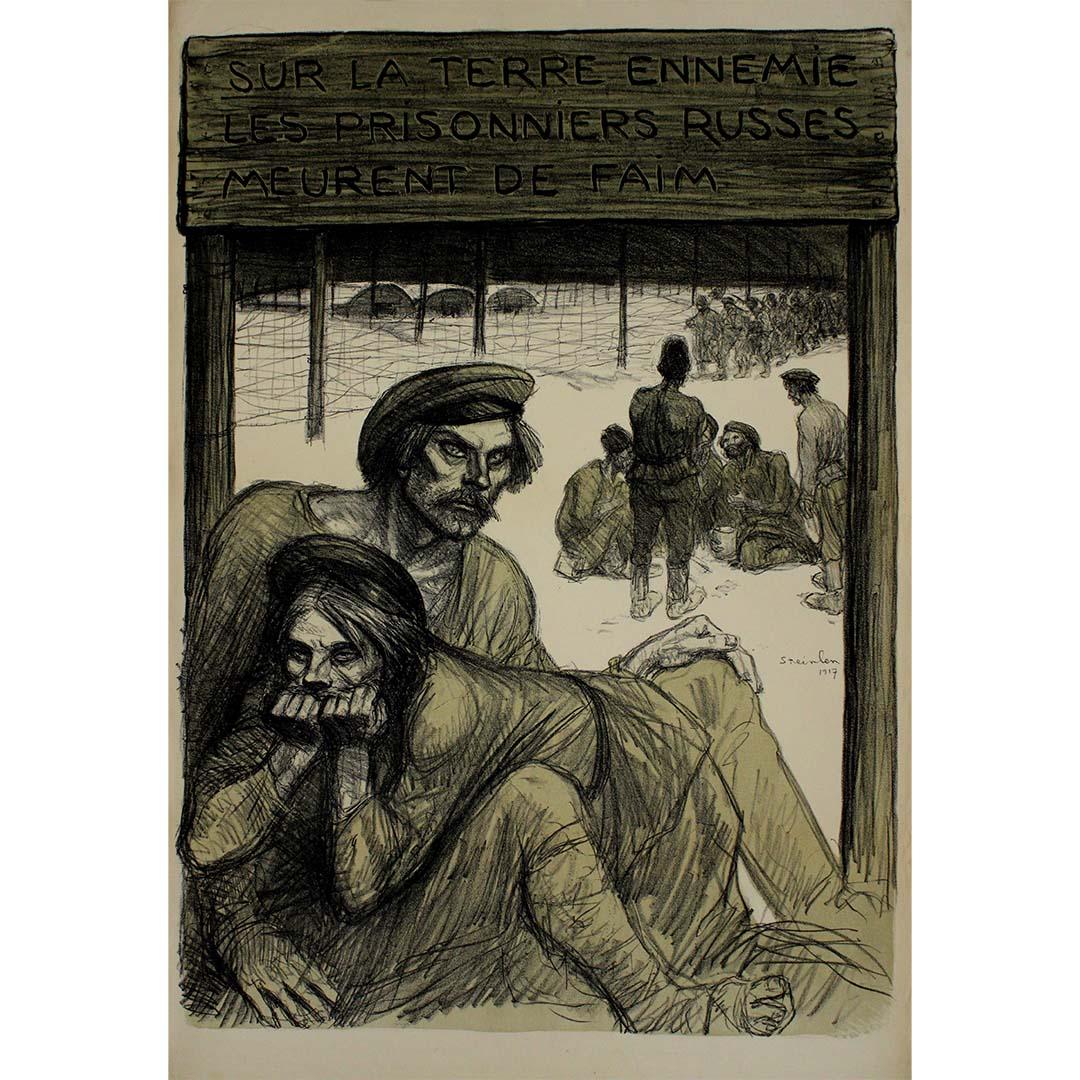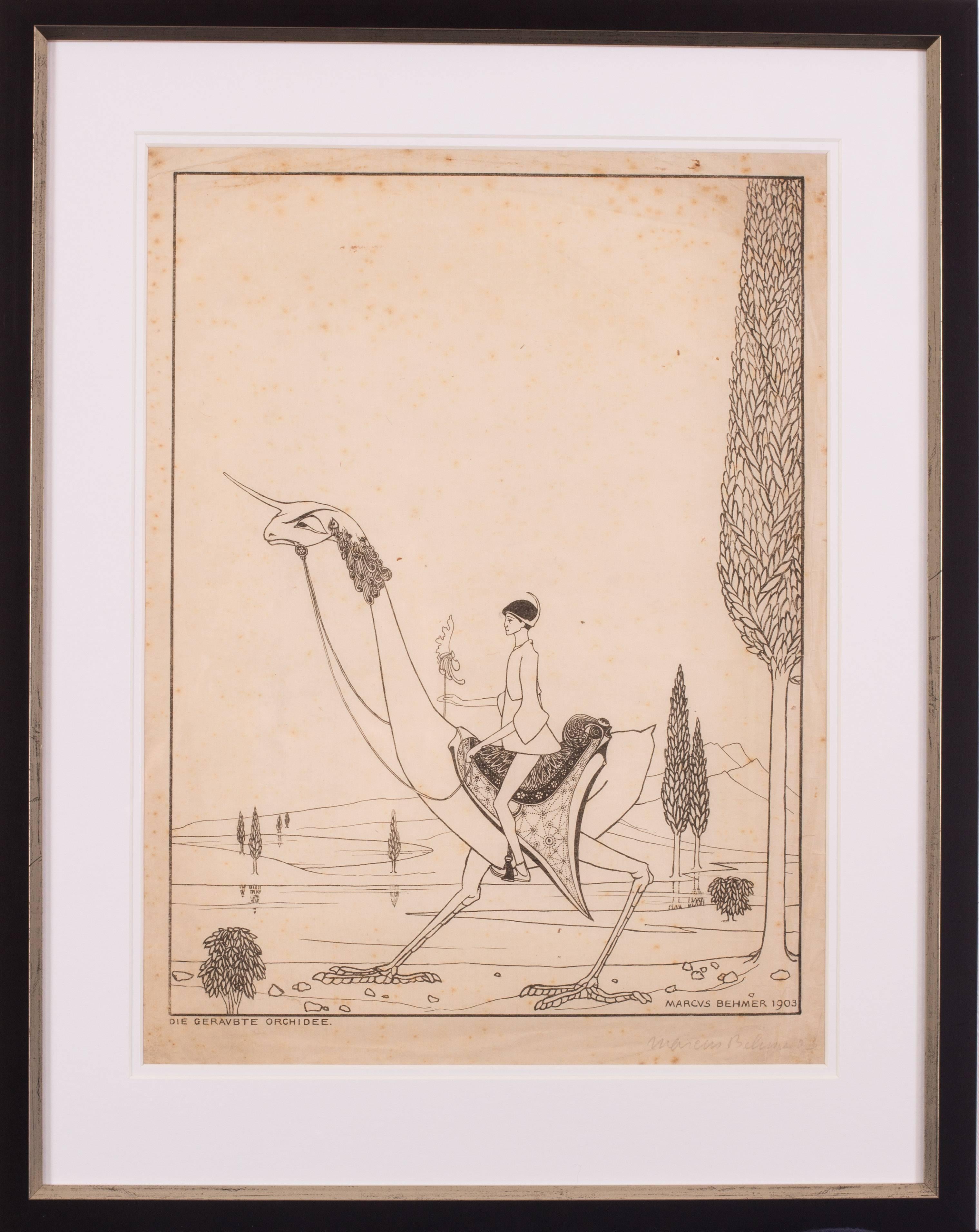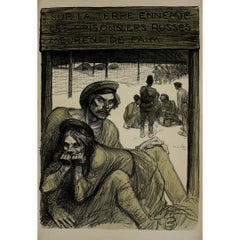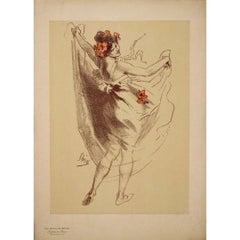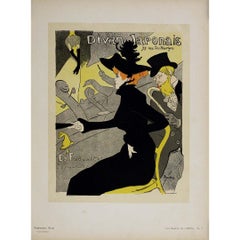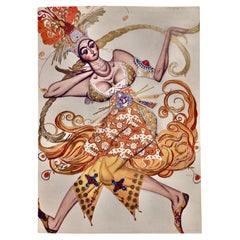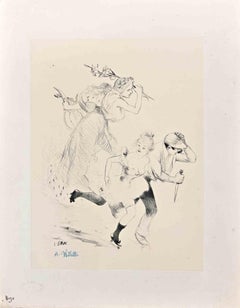Items Similar to Work by Léon Bakst - early 20th-century wartime propaganda Avant-garde
Want more images or videos?
Request additional images or videos from the seller
1 of 8
Leon BakstWork by Léon Bakst - early 20th-century wartime propaganda Avant-gardeCirca 1915
Circa 1915
$1,318.13
£978.20
€1,100
CA$1,816.44
A$1,998.98
CHF 1,048.24
MX$24,259.43
NOK 13,102.82
SEK 12,404.74
DKK 8,376.29
About the Item
This striking work by Léon Bakst, titled “Le grand peintre russe nous promet pour bientôt…” (“The great Russian painter promises us soon…”), vividly captures the spirit of early 20th-century wartime propaganda through the lens of avant-garde art. Known for his influential designs for the Ballets Russes, Bakst brings his dynamic, theatrical style to this political illustration, which portrays a bold leap from the Carpathian Mountains to Berlin, symbolizing a powerful advance into German territory.
Bakst’s image merges patriotic optimism with artistic expression, featuring a dancer in a vibrant red costume making an impossibly long leap across an exaggerated landscape. His body stretches across the expanse of mountains and fields, a striking symbol of movement and power. The vibrant red, an unmistakable focal point, evokes courage, energy, and determination, contrasting with the more subdued figures of the German and Austrian troops below, depicted with a sense of shock and vulnerability. This figure’s fluid, almost acrobatic motion is distinctly reminiscent of the Ballets Russes, known for innovative and expressive choreography—a cultural bridge between Bakst’s art and Russia’s wartime ambitions.
The text at the top translates roughly as, “The great Russian painter, Léon Bakst, promises us soon: ‘From the Carpathians to Berlin, a leap in the style of the Ballets Russes, to the great amazement of these German and Austrian dogs.’” This line reinforces the bold optimism of the artwork, portraying German and Austrian forces in derogatory terms to rally French or Russian sentiment. During World War I, such depictions were not uncommon, as artists used caricature and national symbols to bolster morale and sway public opinion.
The illustration is typical of Bakst’s unique fusion of fine art and theatricality. His background in costume and set design for the Ballets Russes is evident in the highly stylized approach, with a strong sense of movement and drama that extends beyond typical propaganda illustrations. Bakst, celebrated for his vibrant and dramatic visuals, applies similar techniques here, translating his visionary stage design into a politically charged visual commentary. His ability to evoke both elegance and intensity makes this piece an evocative example of art as a tool of wartime communication.
Though primarily known as a designer and painter, Bakst’s venture into political artwork such as this demonstrates the reach and versatility of his talents. The piece stands as a testament to the era's fusion of cultural and political currents, illustrating how artists contributed to the wartime atmosphere by mobilizing their skills in service of national sentiment. Today, this work remains a compelling historical artifact, blending art and politics in a style uniquely Bakst's own.
Original Poster
War 14-18 - Political
Karpaths in Berlin, a leap in the style of the Russian ballets, to the great stupor of these dogs of Germans and Austrians
- Creator:Leon Bakst (1866 - 1924, Russian)
- Creation Year:Circa 1915
- Dimensions:Height: 15.75 in (40 cm)Width: 21.26 in (54 cm)
- Medium:
- Period:
- Condition:Good condition, a trace of fold, on linen.
- Gallery Location:PARIS, FR
- Reference Number:1stDibs: LU1792215362822
About the Seller
5.0
Gold Seller
Premium sellers maintaining a 4.3+ rating and 24-hour response times
Established in 2021
1stDibs seller since 2022
174 sales on 1stDibs
Typical response time: 1 hour
- ShippingRetrieving quote...Shipping from: PARIS, France
- Return Policy
Authenticity Guarantee
In the unlikely event there’s an issue with an item’s authenticity, contact us within 1 year for a full refund. DetailsMoney-Back Guarantee
If your item is not as described, is damaged in transit, or does not arrive, contact us within 7 days for a full refund. Details24-Hour Cancellation
You have a 24-hour grace period in which to reconsider your purchase, with no questions asked.Vetted Professional Sellers
Our world-class sellers must adhere to strict standards for service and quality, maintaining the integrity of our listings.Price-Match Guarantee
If you find that a seller listed the same item for a lower price elsewhere, we’ll match it.Trusted Global Delivery
Our best-in-class carrier network provides specialized shipping options worldwide, including custom delivery.More From This Seller
View AllOriginal 1917 lithographic poster by Steinlen - World War I
By Théophile Alexandre Steinlen
Located in PARIS, FR
This haunting original 1917 lithographic poster by the renowned Swiss-French artist Théophile Steinlen was created during the final years of World War I. The stark title, "Sur la ter...
Category
1910s Prints and Multiples
Materials
Paper, Lithograph
1898 Jules Chéret first supplement to Les Maîtres de l’Affiche - La danse
By Jules Chéret
Located in PARIS, FR
Created in 1898 as the very first supplement to Les Maîtres de l’Affiche, this intimate lithograph distills Jules Chéret’s vision of Belle Époque Paris into a single, buoyant figure....
Category
1890s Prints and Multiples
Materials
Paper, Lithograph
1918 original poster by Adolphe Willette, for the Banque de l'Union Parisienne
By Adolphe Willette
Located in PARIS, FR
The 1918 original poster by Adolphe Willette, created for the Banque de l'Union Parisienne, is a compelling piece of wartime propaganda, urging citizens to contribute to the fourth national loan (4e Emprunt National). This poster, titled Pour que la France soit victorieuse comme à Valmy! (So that France may be victorious like at Valmy!), is a poignant call to action, blending historical reference with patriotic fervor to inspire public support during the final year of World War I.
Adolphe Willette, a prominent French painter, illustrator, and political cartoonist, was known for his evocative and often satirical works. During the war, artists like Willette played a crucial role in shaping public sentiment and encouraging national unity through their art. This particular poster exemplifies his ability to harness the power of visual storytelling to evoke a sense of duty and pride in the French populace.
The poster references the Battle of Valmy...
Category
1910s Prints and Multiples
Materials
Lithograph, Paper
1896 Original poster - Les Maîtres de l'affiche Pl. 2 - Divan Japonais
By Henri de Toulouse-Lautrec
Located in PARIS, FR
Henri de Toulouse-Lautrec's "Divan Japonais, 75 rue des Martyrs" poster, created in 1896, is an emblematic example of the poster art of the period. It is part of the "Maîtres de l'Af...
Category
1890s Art Nouveau Prints and Multiples
Materials
Lithograph, Paper
Original 1917 lithographic poster by Alphonse Grebel - Foire de Paris
By ALPHONSE grebel
Located in PARIS, FR
This original 1917 lithographic poster by Alphonse Grebel was created to promote the Foire de Paris, held from May 1st to 15th during the final years of World War I. Far beyond a sim...
Category
1910s Prints and Multiples
Materials
Paper, Lithograph, Linen
1898 Les Maîtres de l'affiche Pl. 110 - Jane Avril Jardin de Paris
By Henri de Toulouse-Lautrec
Located in PARIS, FR
Henri de Toulouse-Lautrec's "Jane Avril, Jardin de Paris" poster, created in 1898, is an emblematic piece of poster art at the time. It is part of the "Maîtres de l'Affiche" collecti...
Category
1890s Art Nouveau Prints and Multiples
Materials
Lithograph, Paper
You May Also Like
Histoire de Leon Bakst Rare French 1924 Edition #94 of 345 Ballet Russes designs
By Leon Bakst
Located in Glenford, NY
Histoire de Leon Bakst
Copyright by Edition “L’Art Russe” Alexandre Kogan
ECrite par Andre Levinson
Societe D’Editions et de Librairie Henri Reynaud PARIS
This is number 94 of ...
Category
Vintage 1920s French Art Nouveau Books
Materials
Paper
Dangerous Jokes - Lithograph by Adolphe Willette - Early 20th Century
By Adolphe Willette
Located in Roma, IT
Dangerous Jokes is an Original Lithograph realized by Willette (Adolphe Léon).
Good condition on a yellowed paper.
Hand signed with blue pencil on the lower left corner.
Adolphe ...
Category
Early 20th Century Art Nouveau Figurative Prints
Materials
Lithograph
Leon Bakst Three Costume designs from Le Dieu Bleu Ballet 1911
By Leon Bakst
Located in Paonia, CO
Three iconic Leon Bakst costume designs for Le Dieu Bleu ( The Blue God ) a ballet choreographed by Michel Fokine and written by Cocteau. The ballet premiered in Paris in 1912. It tells the story of a girl who tries to dissuade her fiancé from becoming a priest and is thereafter tormented by demons; but she is eventually saved by the Blue God, a part performed by Vaslaw Nijinsky, the greatest male dancer of his time. Fokine’s choreography and Bakst’s costumes drew upon Siamese dance and Hindu sculpture. These three prints are vintage reproductions quite unlike the reproductions of today. They each have the look of original watercolors and are backed on heavy grey rag paper with a hand painted gold border. Properly framed they will definitely look like the original drawing. The size of the actual prints varies slightly but the background paper size is consistently 10.5 x 15.5.
Born in Russia in 1866, Léon Bakst belonged to a young generation of European artists who rebelled against 19th-century stage realism, sparking a revolution in theatre design. His fame lay in the sets and costumes he designed for Serge Diaghilev’s (1872 – 1929) legendary dance company the Ballets Russes, and his huge pageant spectaculars for the dancer and patron of the performing arts, Ida Rubinstein...
Category
20th Century Art Nouveau Figurative Prints
Materials
Color
Lidia - Lithograph (Les Maîtres de l'Affiche), 1895
By Jules Chéret
Located in Paris, IDF
Jules Chéret
Lidia (Alcazar d'été), 1895
Stone ithograph
Printed signature in the plate
On vellum
Size 39 x 29 cm (c. 15.3 x 11.4")
INFORMATION : Plate 25 of "Les Maîtres de...
Category
1890s Art Nouveau Figurative Prints
Materials
Lithograph
Original early 20th Century German signed lithograph by Marcus Behmer
By Marcus Behmer
Located in Petworth, West Sussex
Marcus Behmer (German, 1879 – 1958)
Die Geravbte orchidee (The robbed orchid), 1903
Signed ‘Marcus Behmer’ (lower right in pencil)
Lithograph on paper
16.1/8 x 12in. (40.8 x 30.5cm.)
It is apparent Behmer is influenced by the work of Aubrey Beardsley, though this work is no less beautiful in its execution. Little is known regarding his connections to Oscar Wilde though he is obviously an admirer and has many similarities with his private life and incarceration in prison. These works were a personal gift to Baron Detlev von Hadeln, the aristocrat and prominent art historian of the age.
Behmer is known to be, since 1903, a member in the first ever homosexual organization in Berlin and was thus probably a part of Adolf Brand’s circle, and may have contributed to Brand’s publication Der Eigene. Until now, few know that Behmer was sentenced in April 1937 by a court in Konstanz to imprisonment for two years, being arrested in Freiburg and at other locations in southern Germany for being a homosexual. At times he was given the opportunity to work as an artist in prison. The works produced in this period are mostly calligraphic designed tablets with Greek text (prayers and Bible quotes...
Category
Early 20th Century Art Nouveau More Prints
Materials
Lithograph
"Laderlappen" Original Lithograph Poster by Walter Schnackenberg
By Walter Schnackenberg
Located in Chicago, IL
Printed by Oscar Consee, Munich, 1922
Not much is known about this Stockholm-based cabaret act. Translating literally as Bat Man, we see a young dancer tease an oversized bat wearing a monocle -- a truly bizarre but beautiful design. (text by Jack Rennert)
Walter Schnackenberg’s style changed several times during his long and successful career. Having studied in Munich, the artist traveled often to Paris where he fell under the spell of the Henri de Toulouse-Lautrec’s colorful and sensuous posters depicting theatrical and decadent subjects. Schnackenberg became a regular contributor of similar compositions to the German magazines Jugend and Simplicissimus before devoting himself to the design of stage scenery...
Category
1920s Art Nouveau Figurative Prints
Materials
Lithograph
More Ways To Browse
Poster 1970 Picasso
Rebecca Baird On Sale
Reclining Woman Print
Reginald Marsh Etching
Salvador Dali God
Salvador Dali Signed Prints Flowers
Shepard Fairey 2000
Shepard Fairey Numbered Print
Soviet Posters 1930
Spa Poster
Steven Kenny
Thomas Hart Benton Lithographs
Vietnam Poster
Vintage Poster San Francisco
Warhol Campbell Soup Print
Woodblock Prints Contemporary
1 Cent Life
Alexandra Nechita Lithograph
